Summary Pilot error on landing Crew 6 Survivor 0 | Passengers 44 Survivors 0 Date 17 November 2013 Fatalities 50 (all) Passenger count 44 | |
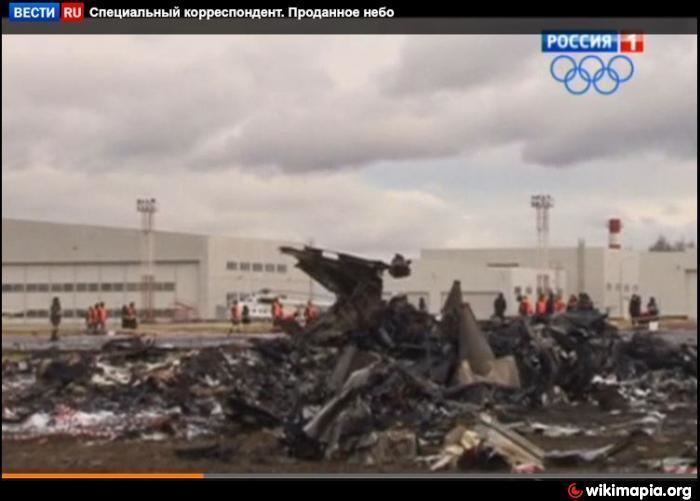 | ||
Similar Aeroflot Flight 821, National Airlines Flight 102, Lao Airlines Flight 301, Flydubai Flight 981, SCAT Airlines Flight 760 | ||
Crash of tartarstan tatarstan airlines flight 363 on 17 november 2013
Tatarstan Airlines Flight 363 was a scheduled domestic passenger flight, operated by Tatarstan Airlines on behalf of Ak Bars Aero, from Moscow to Kazan, Russia. On 17 November 2013, at 19:24 local time (UTC+4), the Boeing 737-500 crashed during an aborted landing in Kazan International Airport, killing all 44 passengers and 6 crew members on board.
Contents
- Crash of tartarstan tatarstan airlines flight 363 on 17 november 2013
- Tatarstan airlines flight 363 crash security cam footage
- Aircraft
- Crash
- Victims
- Investigation
- Official report
- Alternative opinion report
- Aircraft certificate suspension
- Aftermath
- References
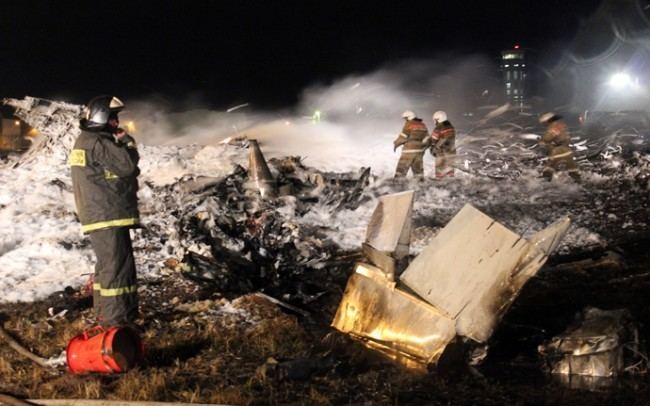
According to the official investigation report, the crash was a result of pilot error, arising from a lack of skill to recover from an excessive nose-up attitude during a go-around procedure. The pilots’ deficiencies were caused by a deficiency in the airline's safety management and a lack of regulatory oversight. One member of the commission filed an alternative opinion report, however, claiming that the commission had ignored the possible malfunction of the aircraft's elevators' controls.
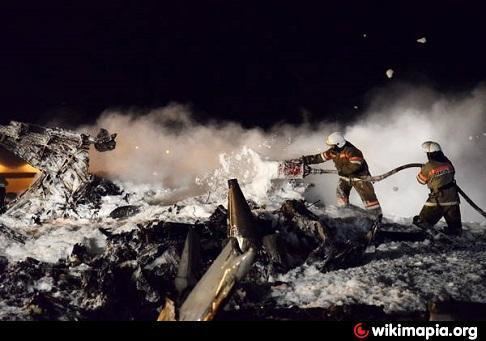
Tatarstan airlines flight 363 crash security cam footage
Aircraft
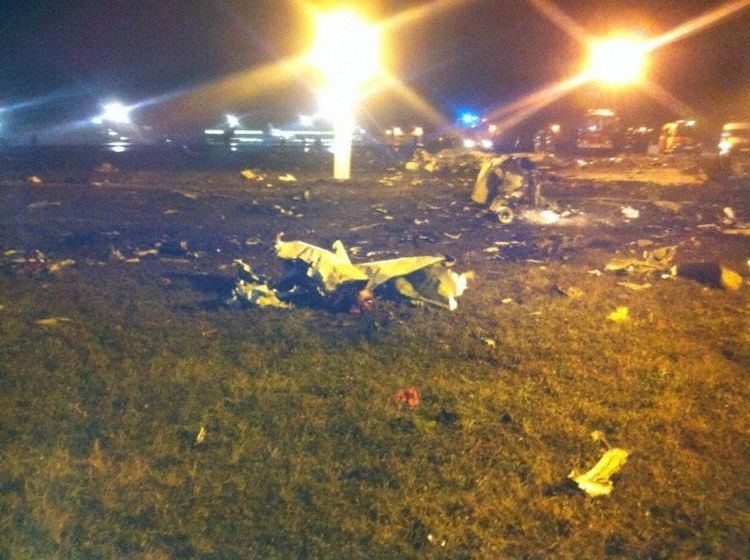
The Boeing 737-53A, registration number VQ-BBN, had been in service for more than 23 years. It had been operated by seven airlines. Owned by AWAS from its manufacture (Boeing customer code 3A represents AWAS), it was leased to Euralair (1990 to 1992, registered F-GGML), Air France (1992 to 1995, still as F-GGML), Uganda Airlines (1995 to 1999, registered 5X-USM), Rio Sul (2000 to 2005, registered PT-SSI), Blue Air (2005 to 2008, registered YR-BAB), Bulgaria Air (several months in 2008, registered LZ-BOY), and Tatarstan Airlines (late 2008 until it crashed).
The airframe had been involved in two prior incidents:
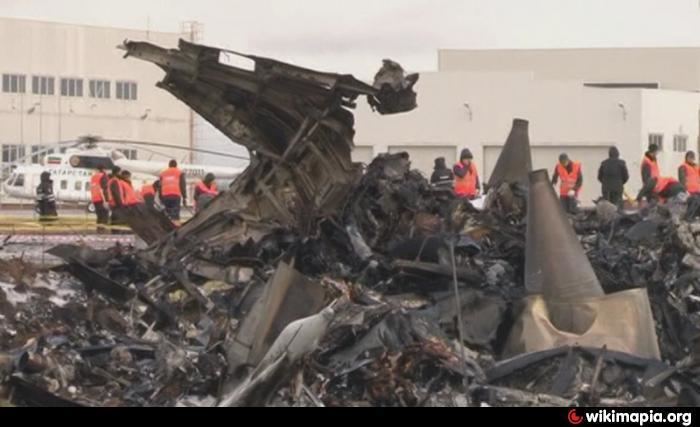
- While in service with Rio Sul, on 17 December 2001, the aircraft crashed about 70 metres (230 ft) short of the runway while landing at Tancredo Neves International Airport under adverse weather conditions, damaging its landing gear. All 108 passengers and crew on board survived.
- On 26 November 2012, the aircraft made an emergency landing in Kazan due to problems with cabin depressurization shortly after take off.
Crash
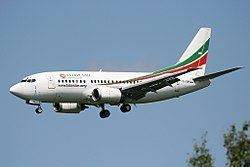
Flight 363 took off from Domodedovo International Airport in Moscow at 6:25 p.m. local time, destined for Kazan International Airport, some 800 kilometres (500 mi) east of Moscow.
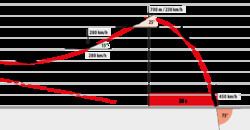
Whilst on final approach to Kazan International Airport, the crew initiated a go-around due to an unstable approach but crashed onto the runway in a 75-degree-nose-down attitude, at a speed of 242 knots (448 km/h), moments later, and exploded upon impact with the ground. A second explosion occurred 40 seconds after impact. One of the airport's surveillance cameras caught the crash on video. All 44 passengers and 6 crew members were killed; there were no casualties on the ground. High winds and cloudy conditions were reported at the airport at the time of the crash.
The Kazan International Airport was kept closed for about 24 hours, serving only transit flights, before it was fully reopened on 18 November.
Victims
The full list of the passengers and crew was published by the Ministry of Emergency Situations. Among the deaths were Irek Minnikhanov, son of Tatarstan president Rustam Minnikhanov, as well as the head of Tatarstan's Federal Security Service regional office, Aleksandr Antonov.
Investigation
The Interstate Aviation Committee (IAC) launched an investigation into the crash and arrived at the site on 18 November. Both flight recorders, the flight data recorder (FDR) and the cockpit voice recorder (CVR), were recovered from the wreckage. The Tatarstan Transport Prosecution Office has opened a criminal investigation into the crash. The American National Transportation Safety Board (NTSB) dispatched a team of investigators to the crash site.
On 19 November, Aksan Giniyatullin, the director of Tatarstan Airlines, declared that although the cockpit crew was experienced, the captain of the airliner may have lacked experience performing a go-around maneuver. Moments before the crash the pilot informed the control tower that the aircraft was not properly configured for landing and initiated a go-around, before plunging into the ground as if it had stalled. Investigators said the possible causes of the accident included technical malfunction as well as pilot error.
On 22 November the British Air Accidents Investigation Branch announced they had joined the investigation and had dispatched investigators to Kazan.
Official report
On 19 November 2013, the Investigation Board of IAC reported the following preliminary details after recovering some information from the flight data recorder:
Tatarstan Airlines Boeing 737-500 Accident Technical Investigation Board of IAC informs about preliminary results of flight data recorder information recovery.
During the final approach the flight crew were unable to follow a standard landing pattern defined by the regulating documentation. Having considered the aircraft is not lined-up properly relative to the runway, the crew reported to the ATC and started to go-around using the TOGA (Take Off / Go Around) mode. One of the two autopilots, which was active during the final approach, has been switched off and the flight was being controlled manually.
The engines reached thrust level close to full. The crew retracted the flaps from 30 degrees to 15 degrees position.
Affected by the upturn moment generated by the engine thrust, the aircraft started to climb, reaching the pitch angle of about 25 degrees. Indicated airspeed has started to decrease. The crew retracted the landing gear. Since initiating the go-around maneuver up to this moment the crew did not perform control actions through the yoke.
After the airspeed decreased from 150 to 125 knots, the crew started control actions through the yoke, pitching nose down, which has led to stopping climb then starting descent and increase of the airspeed. Maximum angles of attack have not exceeded operational limits during the flight.
After reaching the altitude of 700 meters, the aircraft started a steep nosedive, with the pitch angle reaching −75° by the end of the flight (end of the recording).
The aircraft collided with terrain at high speed (exceeding 450 km/h) and with highly negative pitch angle.
About 45 seconds have passed between the moment of starting go-around maneuver and the moment the recording stopped, the descent took about 20 seconds.
The propulsion systems were operating up to the collision with terrain. No single commands have been detected by the preliminary analysis, which would indicate failures of systems or units of the aircraft or engines.
On 24 December 2015, the Interstate Aviation Committee released their final report stating that the crash was caused by an under-qualified crew who lacked the skills to recover from an excessive nose up attitude during a go-around procedure. The go-around was necessitated by a positional error in the navigation system, a map drift. The pilots’ deficiencies were caused by lack of airline safety management and lack of regulators’ oversight.
According to the final report, during the final approach the crew initiated a go-around, but being under high workload, which possibly caused a "tunnel vision effect", they did not perceive warning messages related to auto-pilot disconnection. When the plane climbed to 700 m, its pitch angle reached 25 degrees and the airspeed dropped to 230 km/h. At that moment the captain, who never performed a go-around before, apart from the training, moved the yoke, pitching nose down, which led to stopping climb and started descent and increase of the aircraft's airspeed. After reaching the altitude of 700 m, the aircraft started a steep nosedive, with the pitch angle reaching −75° when the aircraft impacted the ground. The plane crashed on the airport's runway with a speed exceeding 450 km/h. The time from the start of the go-around maneuver until the impact was about 45 seconds, including 20 seconds of aircraft descent.
Alternative opinion report
Nikolay Studenikin, the official representative of the Rosaviatsiya in the air accident investigation commission, has filed an alternative opinion report, where he expressed his disagreement with the conclusions of the commission.
In it, he states that the IAC commission has concentrated the investigation on the search of the shortcomings in the flight crew training in Russia, and claims that no direct connection between such shortcomings and the Flight 363 crash was actually established. He also criticized, that the investigation into the possible malfunction of the aircraft’s elevators' controls was entrusted to their manufacture, the US-based Parker Aerospace, which ruled that their controls operated normally during the accident. According to Studenikin, a flight simulation of the crashed flight, which was conducted on the Boeing facilities, was aimed only on proving the crew's fault and didn't simulate a possible mechanical failure in the Boeing aircraft.
Aircraft certificate suspension
Rosaviatsiya refused to accept the results of the IAC's Flight 363 accident investigation, citing their concern over the Boeing 737's elevators' controls. IAC accused Rosaviatsiya, that their position is actually caused by the reluctance to accept the shortcomings of Rosaviatsiya's regulatory oversight of pilots training in Russia, which was revealed in the report. On 4 November 2015, IAC unexpectedly announced the suspension of Boeing 737 flying certificates in Russia, explaining it by Rosaviatsiya's refusal to accept the absence of safety issues with 737 elevators' controls.
With the Boeing 737 being a work-horse of several Russian airlines, the suspension meant that within days the significant part of the country's passenger fleet could be grounded for an uncertain period of time. Dmitry Peskov, a spokesman for the Russian President, said that Kremlin was aware of the IAC decision to suspend Boeing 737 operation in Russia and believed that the specialized agencies and the Cabinet would make the necessary analysis of the situation. Ministry of Transport said that only six out of 150 Boeing 737 aircraft in Russia have the certificates issued by IAC, the rest got their certificates in other countries and thus IAC has no right to suspend them. Rosaviatsiya announced that the IAC had no right to ban any Boeing 737 operation in Russia, as such a decision could be made only by the federal executive bodies. It called an emergency meeting to discuss the future of Boeing 737 in Russia with the participation of Ministry of Transport, Rostransnadzor, airline representatives and a Boeing representative in Russia, but IAC refused to attend it. The next day IAC withdrew its suspension of Boeing 737 certificates.
On 10 December 2015, the IAC on its meeting officially accepted its Flight 363 final accident investigation report. Rosaviatsiya and Studenikin refused to participate in this meeting or provide their approval for the report.
Aftermath
In early December 2013 (2013-12), Russia's Federal Air Transport Agency recommended that the airline's certificate should be revoked. The revocation was announced on 31 December 2013, and the aircraft part of the company was transferred to Ak Bars Aero.
